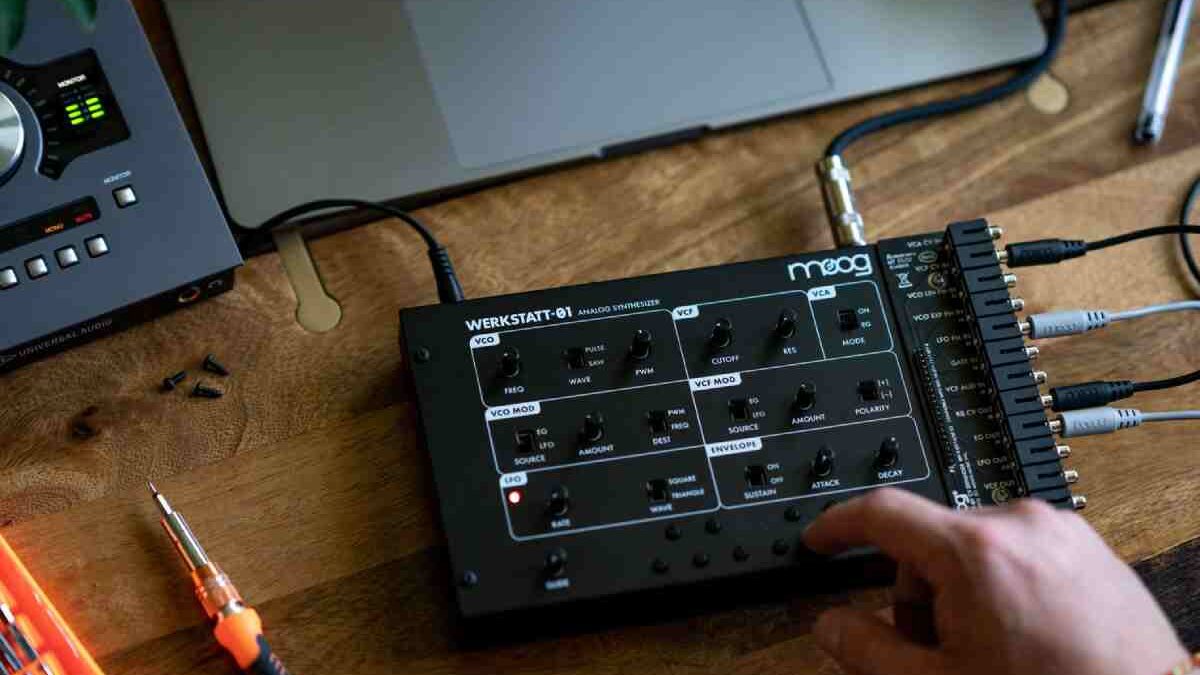Table of Contents
Moog Werkstatt
Moog Werkstatt: Moog Music announced they had discontinued the Werkstatt-01, a minimal analog synthesizer with modular capabilities.
The Werkstatt-01 was unveiled initially at Moogfest 2014.
Projects
The projects are more advanced and some, like Push Button Vibrato and Arpeggiator/Sequencer.
- Require the addition of the (very affordable) Arduino Uno microcontroller board and the ability to load simple code onto it. But this is how it should be.
- The Werkstatt ø1 helps you start at a basic level and then helps you work on progressively more complex projects to understand electronics and synth operation better.
- However, you can even download the 3D printer files on the website to create dedicated cases for some of your completed projects, which is a charming touch.
- For experienced engineers, Moog has provided an array of 16 x 6 solder points (experiment pads) on the Werkstatt ø1 circuit board, allowing them to add circuitry within the synthesizer itself.
- Here are also numerous test points and jumper positions that allow advanced hackers to insert or extract signals of their choice.
- But if he is unsure of their abilities, I advise you to leave them alone. It can deal significant damage if he pokes inside any synth with a rogue soldering iron.
Technology
A result is a neat unit that offers a single but wide range VCO generating sawtooth and pulse/PWM waves, a 24dB/oct self-oscillating/resonant low pass ladder filter, and a VCA with permanently on modes (drone). ). ) and EG.
- A single triangle/square LFO is provided, which can be routed to the VCO pitch or pulse width or the filter cutoff frequency.
- The contour generator is a simple variable instantaneous attack/decay (AD) device with an optional sustain stage that makes it an ASR generator. You can direct it to VCA gain, VCO pitch, pulse width, and at the filter cutoff.
- Out of frequency with positive or negative polarity. However, the top panel controls only allow each destination to respond to one source at a time.
- You can’t (for example) sweep and move the pulse width simultaneously.
- Finally, 13 small knobs provide an octave of pitch control, and a twist generator generates portamento.
- On the right side of the Werkstatt ø1, you’ll find a 20-hole header with all sorts of fantastic legends, like VCF In, VCF Aud In, VCO Out, etc.
- The first five are CV inputs, the sixth is audio, and the remaining 14 holes are dual outputs for each of the seven audio and CV outputs.
- The synth comes with five short cables (and you can buy more) that allow you to connect this to that.
- When you do, you’ll find that internally applied CVs add up with externally directed ones, meaning you can now move and sweep simultaneously ( or anything else you want).
- You can also solder patch cords to connect external devices to the ø1. But the optional breakout board (which should be available when you read this) is a much more elegant solution.
- The CV Expander by Moog can be installed quickly and easily by removing two of the original screws from the assembled synth. Pressing the plate into place, and then, using two longer screws, attaching it to the case.
- The board provides all 12 inputs and outputs of the Werkstatt ø1 on 3.5mm jacks. So now you’re ready to rock and roll.
Conclusion
- Moog released the Werkstatt ø1 in its current form, quirks and all because its customers demanded it.
- I suspect there were vague thoughts beforehand that its underlying technology might lead somewhere interesting.
- Still, there were no plans to turn Moogfest’s kit into a commercial product. And I think the company was genuinely surprising at the level of interest it generated.

